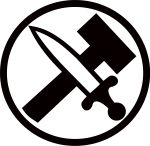Black Front
Combat League of Revolutionary National Socialists Kampfgemeinschaft Revolutionärer Nationalsozialisten | |
|---|---|
 | |
| Leader | Otto Strasser |
| Founders | Otto Strasser Hermann Ehrhardt[1] |
| Founded | 4 July 1930 |
| Banned | 15 February 1933[2] |
| Split from | Nazi Party |
| Succeeded by | German Social Union (not legal successor) |
| Headquarters | Berlin |
| Newspaper | The German Revolution |
| Ideology | Strasserism |
| Political position | Far-right |
| Colours | Black Red |
| Party flag | |
 | |
The Combat League of Revolutionary National Socialists (German: Kampfgemeinschaft Revolutionärer Nationalsozialisten, KGRNS), more commonly known as the Black Front (German: Schwarze Front), was a political group formed by Otto Strasser in 1930 after he resigned from the Nazi Party (NSDAP) to avoid being expelled.[3][4]
Strasser formed the Black Front to continue what he saw as the original anti-capitalist stance of the Nazi Party, embodied in several items of its 25-point Program of 1920 that was in large part ignored by Adolf Hitler, which Strasser saw as a betrayal. The group's reflected Strasser's political views, such as revolutionary nationalism, and its criticism of capitalism was expressed in economic antisemitic terms rather than socialism. The Black Front was composed of former radical Nazis who intended to cause a split in the party, and adopted the crossed hammer and sword symbol that is still used by several Strasserite groups. The group published a newspaper entitled The German Revolution.[3]
The Black Front, which never had more than a couple of thousand members,[4] was unable to effectively oppose the Nazis. Hitler's rise to power as Chancellor of Germany proved to be the final straw. The remaining anti-capitalist elements of the Nazis were eradicated in 1934 during the Night of the Long Knives, in which Gregor Strasser, Otto's older brother, was killed. Strasser had previously broken with his brother over Otto's proclivity to act on his own.[4] Otto Strasser spent the years of the Third Reich in exile, first in Czechoslovakia (then the First Czechoslovak Republic) and later in Canada, before returning to West Germany in 1953.[5]
See also
References
- ^ Brown, Timothy S. (2009). Weimar Radicals: Nazis and Communists Between Authenticity and Performance. New York: Berghahn Books. p. 71. ISBN 978-1-845-45564-4.
- ^ Nolzen, Armin (2013). "Straßer, Otto". Neue Deutsche Biographie (in German). Vol. 25. pp. 479–481.
- ^ a b Wistrich, Robert S. (4 July 2013). Who's Who in Nazi Germany. New York: Routledge. p. 248. ISBN 978-1-136-41381-0.
- ^ a b c Ullrich, Volker (2017). Hitler: Ascent: 1889–1939. Translated by Chase, Jefferson. New York: Vintage. p. 228. ISBN 978-1-101-87205-5.
- ^ Elzer, Herbert (2012). "Bonn oder Paradise? Die Bundesregierung, der SPD-Parteivorstand und die umstrittene Rückkehr des NS-Dissidenten Otto Straßer aus Kanada (1948–1952)" [Bonn or Paradise? The Federal Government, the SPD Party Leadership and the Controversial Return of the National-Socialist Dissident Otto Strasser from Canada]. Jahrbuch Extremismus & Demokratie (in German). 24. Baden-Baden: Nomos: 72–101. doi:10.5771/9783845244372-72.
- 1930 establishments in Germany
- 1933 disestablishments in Germany
- Banned far-right parties
- Far-right political parties in Germany
- Fascist organizations
- German nationalist organizations
- German nationalist political parties
- Nazi parties
- Organizations disestablished in 1933
- Organizations established in 1930
- Political organisations based in Germany
- Strasserism
- Syncretic political movements
- Third Position
